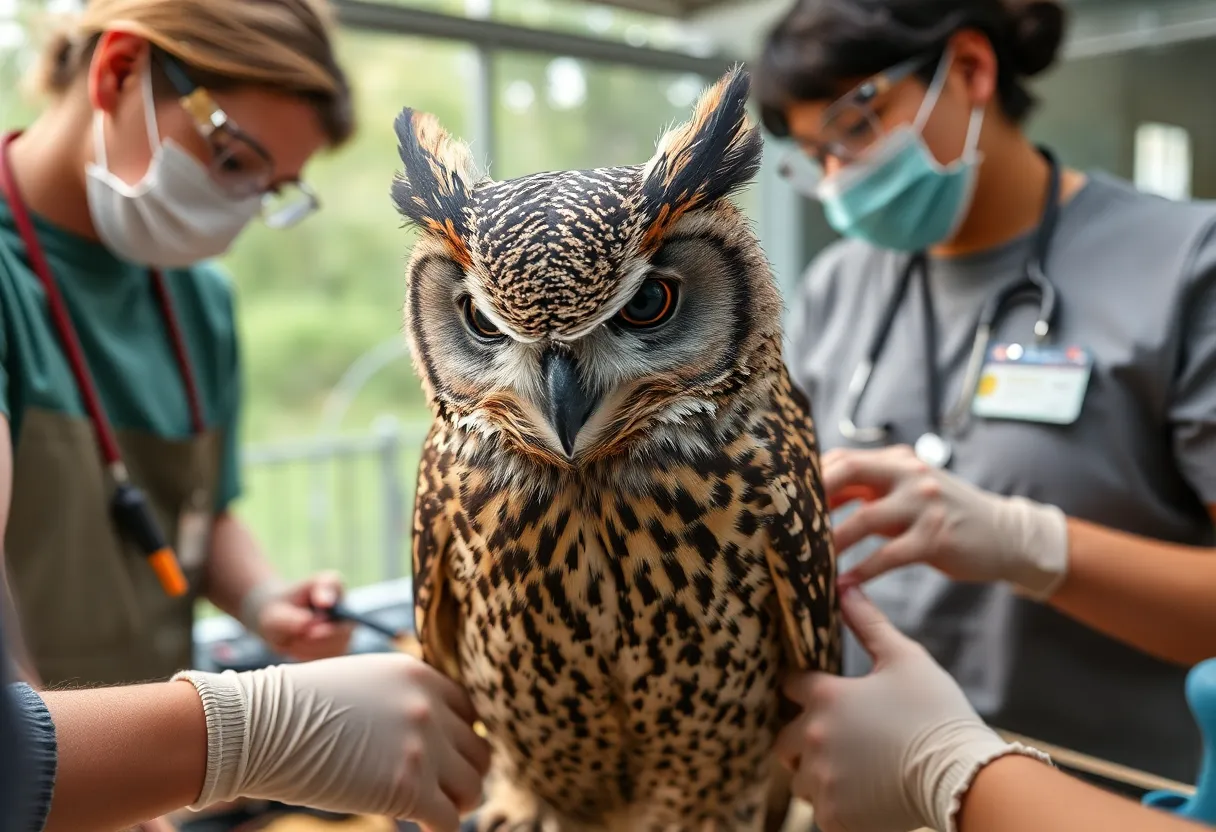News Summary
A great horned owl was trapped in a glue trap in Orange County, causing severe rehabilitation challenges due to lost feathers. Rescued by a Good Samaritan, the owl was treated at the Wetlands and Wildlife Care Center. Experts stress the risks of glue traps for wildlife, urging the community to avoid their use. Proposed legislation to ban glue traps has stalled, but local initiatives continue to support animal rescues. The recovery process for the owl may take time, impacting its potential return to the wild. The case highlights the importance of animal care and community support in wildlife rehabilitation.
Huntington Beach, California – A great horned owl became trapped in a glue trap in Orange County, leading to significant health concerns and challenges for its rehabilitation. The incident, which left the owl unable to fly or hunt for food, was brought to light when a Good Samaritan discovered the distressed bird and transported it to the Wetlands and Wildlife Care Center.
Efforts to free the owl included an attempt to cut its wings out of the sticky trap using scissors. Unfortunately, this method resulted in the loss of a large number of feathers, making the bird’s recovery process more complicated. The director of the wildlife center emphasized that cutting feathers can severely impede a bird’s rehabilitation, as feathers do not regenerate if they are cut; instead, birds must undergo a complete molt for new feathers to grow. Most owls undergo molting once a year, and larger species like great horned owls may require two or more years to replace all their feathers.
In the best-case scenario, the owl could potentially regrow enough feathers to be released back into the wild within a year. However, the injury could also result in a longer rehabilitation period, which may affect the bird’s reintegration into its natural habitat. If returning to the wild is not feasible, the owl may serve as an educational ambassador, highlighting the dangers associated with glue traps.
Upon arrival at the Wetlands and Wildlife Care Center on July 23, the owl was treated with vegetable oil and solvents to remove the remaining glue. It received washing, food, and water before being moved to the Orange County Bird of Prey Center for further rehabilitation. This incident underscores the serious threats that glue traps pose to various forms of wildlife, a fact that has led to them being banned in several countries including England, Iceland, and New Zealand.
The veterinarian who treated the owl has urged the local community to refrain from using glue traps, as they often ensnare unintended wildlife. The Wetlands and Wildlife Care Center reported frequently receiving rescue calls for animals caught in glue traps, which occur approximately once a month. In addition to great horned owls, other species such as orioles and barn owls have also fallen victim to these traps.
In January 2024, U.S. Representative Ted Lieu proposed a national ban on glue traps, but the initiative did not move forward in the legislative process. The center’s director has advised that individuals rescuing caught birds should avoid cutting feathers and instead gently wrap the animals in a towel, transporting them to a rescue center for proper assistance.
Last year, the Wetlands and Wildlife Care Center successfully rehabilitated around 8,600 injured or sick animals, and they welcome assistance and guidance for individuals outside of Orange County regarding local treatment centers. Support has already been seen from wildlife enthusiasts, who donated dish soap to help clean the owl after a social media call for donations led to receiving 100 jugs within mere hours. Other supplies needed, including paper towels and bleach, are available on the center’s Amazon wishlist.
The recovery process for the great horned owl is expected to be lengthy due to the slow feather regrowth cycle characteristic of its species. As the center continues to care for the bird, it remains hopeful that through proper rehabilitation, the owl may one day regain its ability to soar into the wild once more.
Deeper Dive: News & Info About This Topic
HERE Resources
Additional Resources
- Los Angeles Times: Great Horned Owl Rescued
- Los Angeles Times: Local Wildlife Enthusiasts Aid Owl Rescue
- OC Register: Attracting Owls to Urban Neighborhoods
- WXII12: Bird Flu and Owl in Wake County
- Patch: Rare Great Horned Owl Sighted
- Wikipedia: Great Horned Owl
- Google Search: Great Horned Owl Rescue
- Google Scholar: Great Horned Owl Rehabilitation
- Encyclopedia Britannica: Great Horned Owl
- Google News: Great Horned Owl

Author: STAFF HERE COSTA MESA WRITER
The COSTA MESA STAFF WRITER represents the experienced team at HERECostaMesa.com, your go-to source for actionable local news and information in Costa Mesa, Orange County, and beyond. Specializing in "news you can use," we cover essential topics like product reviews for personal and business needs, local business directories, politics, real estate trends, neighborhood insights, and state news affecting the area—with deep expertise drawn from years of dedicated reporting and strong community input, including local press releases and business updates. We deliver top reporting on high-value events such as the OC Fair, Concerts in the Park, and Fish Fry. Our coverage extends to key organizations like the Costa Mesa Chamber of Commerce and Boys & Girls Clubs of Central Orange Coast, plus leading businesses in retail, fashion, and technology that power the local economy such as Vans, Experian, and South Coast Plaza. As part of the broader HERE network, including HEREAnaheim.com, HEREBeverlyHills.com, HERECoronado.com, HEREHollywood.com, HEREHuntingtonBeach.com, HERELongBeach.com, HERELosAngeles.com, HEREMissionViejo.com, HERESanDiego.com, and HERESantaAna.com, we provide comprehensive, credible insights into California's dynamic landscape.


